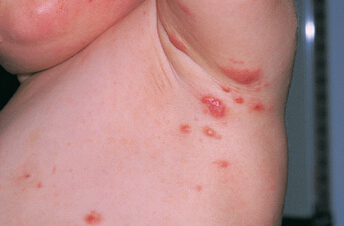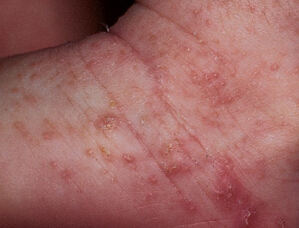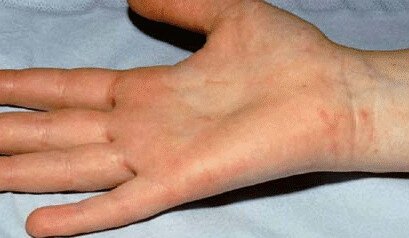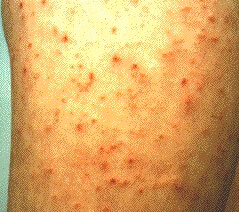Scabies is a type of skin infestation caused by Sarcoptes scabiei var. hominis (the human itch mite). This microscopic scabies mite will burrow into the top layer of skin and then live there, laying eggs. Scabies can spread easily between people and affect everyone. Through proper treatment, scabies mites will die, leading to the disappearance of the itching over the course of several days or weeks. If it is not treated, however, the mites will keep reproducing beneath the skin, leading to increased itching and sores. Many people with itchy skin or sores find themselves wondering “Do I have scabies?” so it helps to recognize the signs.
How to Tell If You Have Scabies
Some of the symptoms of scabies include:
- Itching at Night
This is the most common symptom, and one of the methods to tell if you have scabies is whether the itching occurs particularly at night and keeps you up.
- Rash
Another great way is to check for a rash as many people with the condition develop one. This rash will be in the form of small bumps that frequently appear in a line. The bumps may appear similar to pimples, knots underneath the skin, tiny bites, or hives. Some people will even develop eczema-like scaly patches. Rashes usually follow itching and occur along armpits, buttocks, abdomen, thighs, and women’s nipples.
- Sores
If a person with scabies scratches the itchy rash, they may develop sores and these can become infected.
- Scratching
For many people, how to tell if you have scabies relies on the amount of scratching you feel the need to do. Many with severe itches will feel the need to scratch non-stop and this can lead to infections. In rare cases, the infection may even enter the blood, leading to sepsis which can be life-threatening.
- Mite Tunnels
These might tunnels or burrows can appear as silvery, dark, or fine lines between 2 and 10 mm in length. They are most common on the hands, inner wrists, and finger webbing, but can occur anywhere and frequently go unnoticed until they begin to itch.
- Worsening of Pre-Existing Conditions of the Skin
Those with itchy skin problems (like eczema or psoriasis) may experience worsening of the symptoms associated with those conditions.
Most Common Places for Symptoms to Occur
The symptoms of scabies can occur in most places, but they are more likely to develop:
- On genitals (or men)
- Near the sides of breasts, the bra line, or nipples (for women)
- On buttocks
- Around navel and waistline
- On outer areas of the armpits and elbows
- On the palm edge of wrists
- Between fingers
Babies or small children may also develop skin irritation or itching along the face, neck, scalp, palms, or soles of their feet.
What About Thick Crusts?
People with crusted scabies, also known as Norwegian scabies (a particular type and a severe form of the condition) can lead to thick crusts along the skin. Each crust is home to between hundreds and thousands of mites as well as their eggs and the large amount of mites leads to severe rash and itching.
How Soon Do You Have Scabies Symptoms?
In the case of someone who has never had scabies in the past, symptoms may not appear for 4 to 6 weeks. Keep in mind that even someone without symptoms can spread scabies as long as they are infected.
Scabies tends to appear much sooner after exposure among those who have previously had scabies, usually within 1 to 4 days.
Pictures of Scabies Symptoms
The following pictures can also help you learn how to tell if you have scabies.
This first picture shows a series of red bumps that are raised along the skin, forming a thick red line. Some of the bumps on the far right side appear to have crusted slightly.

This photo shows multiple raised red bumps, each of which is a different size. The image shows the range of sizes and shapes found in scabies sores and their redness gives an indication of the extent to which they irritate the patient. The superficial part has a scaly appearance.

This picture shows what a mite tunnel or burrow looks like and they can be seen on each side of the patient’s wrist along the crease.

This photo indicates a typical rash that someone will develop in reaction to the scabies mites. In this photo, the rash occurs on the leg.

What to Do If You Have Scabies?
Diagnosis
In most cases, a doctor will be able to diagnose scabies from symptoms alone. One general rule is that the chances increase if you were in close contact with another person who has or had the same or similar symptoms.
In some cases, your doctor will suggest testing to confirm the presence of scabies. An example may be the doctor gently scraping dry skin from an area that is affected and then examine it for mites underneath a microscope.
Treatment
It is crucial to know how to tell if you have scabies because this condition doesn’t go away by itself. Your doctor will prescribe a special medicated lotion or cream to eliminate it and stop it from spreading to those around you. You may also be prescribed pills.
The majority of lotions and creams should be applied to your entire body below the neck. In some cases, you will also apply it to the neck, face, and scalp, but never near the eyes or mouth. Most of the time, the medication should stay on for between eight and fourteen hours before being washed off.
Precautions
Certain scabies medications are not considered safe for pregnant or breastfeeding women, older adults, or children and you should always follow doctor instructions to avoid side effects.
If you develop scabies, anyone that you are in close contact with will need to be treated at the same time as you to prevent the mites from going back and forth. You should not share personal items with anyone until the scabies is clear.
Prevention
- Wash towels, bedding, and clothes used within three days before treatment. Always use the hot cycle and hot water. You can also dry clean the items or put them in a plastic bag for between three and seven days.
- Clean and vacuum all rooms the person with scabies used.
